Modern smartwatches offer robust interval timers with customizable work/rest periods tailored to various training styles like HIIT or endurance workouts. You’ll find features such as programmable sequences, haptic alerts, heart rate zone monitoring, and activity-specific templates. Brands like Garmin provide advanced performance metrics, while Apple Watch supports third-party interval apps that integrate with Apple Health. Most devices allow you to save favorite routines for quick access and adjust intensity levels on the fly. Discover which smartwatch capabilities best match your fitness goals.
What Interval Timers Do Smart Watches Offer?
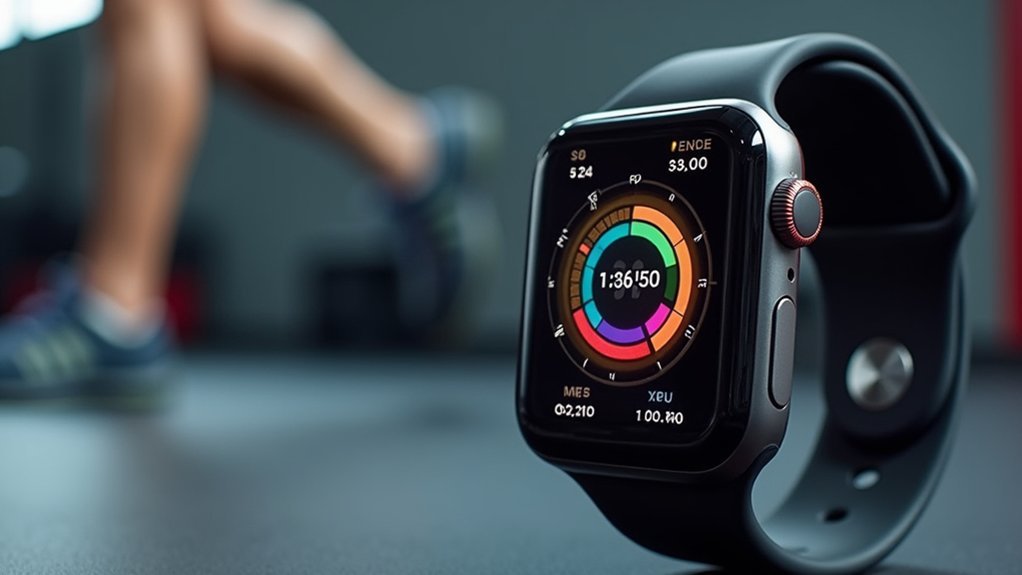
While fitness enthusiasts once relied on basic stopwatches, today’s smartwatches provide sophisticated interval timing capabilities across multiple brands.
You’ll find dedicated interval training plans on the Amazfit Active Edge, while Garmin watches separate tracking data for easier technique analysis.
If you’re using an Apple Watch, you can access third-party interval timer apps that integrate with Apple Health for thorough workout data. Similarly, Wear OS smartwatches support apps like Exercise Timer for building custom routines that match your specific needs.
The Amazfit Active Edge stands out with its ability to set interval training directly on the watch, eliminating the need to pre-program workouts through a companion app.
Across all major brands, these interval timers offer customizable work and rest periods, intensity level adjustments, and the ability to define your preferred number of sets.
Most importantly, these features run smoothly in the background, delivering timely alerts through vibrations or sounds to keep your workouts on track.
The Evolution of Interval Timers in Wearable Technology
The transformation from basic stopwatches to sophisticated smartwatches has revolutionized how you track interval training sessions with unprecedented precision.
Today’s wearable technology offers customizable interval timers that adapt to your specific training needs, whether you’re following Tabata protocols or designing complex HIIT workouts.
This personalization empowers you to optimize your training efficiency while the technology handles the timing, allowing you to focus entirely on your performance. Similar to how EvoWalk wearable technology is designed to restore and rehabilitate walking through personalized solutions, smartwatch interval timers tailor their functionality to individual fitness goals.
From Stopwatches to Smartwatches
Fitness enthusiasts once relied exclusively on mechanical stopwatches with their simple button interfaces and limited functionality to time their interval workouts.
The evolution has been remarkable as technology transformed these basic timing tools into sophisticated training companions.
The journey to modern interval timing technology progressed through three distinct phases:
- Basic timers required manual intervention for each interval change and offered no customization options or data recording capabilities.
- Digital apps introduced programmable intervals with customizable work/rest periods, sound alerts, and templates for different workout types.
- Smartwatch integration now provides standalone operation with haptic feedback, heart rate zone targeting, and the ability to base intervals on time, distance, or count. Modern smartwatches allow users to configure precise interval settings with adjustable rest durations to match their specific training requirements.
You’ll now find these features seamlessly integrated into extensive wearable ecosystems with automatic syncing across your devices.
Technology Drives Precision
From humble mechanical stopwatches to sophisticated wearable computers, interval timers have undergone a remarkable technological transformation over the past few decades.
What began as basic countdown features in early digital watches has evolved into AI-driven training systems on your wrist.
Today’s smartwatches offer unprecedented precision in interval training. You’ll find customizable timing patterns that integrate with your heart rate, ECG, and oxygen saturation levels.
These devices automatically adjust workout intensity based on your real-time performance data.
Touch screens and voice commands make operating your interval timer intuitive, even during intense workouts.
GPS functionality tracks your outdoor sessions, while seamless smartphone connectivity expands your training options.
The precision of modern interval timers doesn’t just make workouts more efficient—it transforms your smartwatch into a thorough fitness coach that adapts to your specific goals.
Modern smartwatches like the Apple Watch use predictive analytics to learn from your interval training patterns and suggest optimized workout routines.
Personalization Transforms Training
Modern personalization capabilities have revolutionized how athletes and fitness enthusiasts approach their interval training. Your smartwatch now adapts to your unique fitness journey, allowing you to create tailored workouts that match your specific goals and abilities.
The customization options available include:
- Adjustable interval patterns – Set precise work and rest periods that align with your training methodology, whether you’re focusing on HIIT, endurance, or strength training.
- Saved workout profiles – Store your favorite routines for quick access, maintaining consistency in your training program.
- Activity-specific templates – Choose from specialized templates for running, cycling, swimming, and weightlifting that optimize performance tracking.
This personalization extends beyond just timing – your device can integrate with music playlists and provide vibration alerts to create a seamless training experience that keeps you focused and motivated. For premium subscribers, the ability to create workouts with unlimited exercises significantly expands training versatility compared to the free version’s three-exercise maximum.
Core Features of Smartwatch Interval Timers
Smartwatch interval timers offer you customizable work-rest cycles that adapt to your specific fitness needs and goals.
You’ll find preset workout templates for popular training methods like HIIT, Tabata, and circuit training that eliminate setup time and help you jump right into your exercise routine.
These timers display your progress with clear visuals while providing audio or vibration alerts to signal changes between workout segments without requiring you to look at your watch. Advanced smartwatches enable you to skip intervals during your workout for a more personalized exercise experience.
Core Features of Smartwatch Interval Timers
While interval training continues to grow in popularity, today’s smartwatch timers offer sophisticated features that transform how users approach their workouts. Your watch can operate independently from your phone, allowing you to run custom workouts directly from your wrist.
Modern interval timers provide:
- Syncing capabilities that let you transfer workout plans to your watch for independent use while preserving phone battery.
- Engineering flexibility through saved presets that enable switching between different activities during your workout.
- Power optimization with features like sleep mode and dark themes that extend battery life up to 35 days on some models.
Many watches also include customizable vibration alerts that notify you when it’s time to switch exercises without disrupting others around you. The latest interval timer apps support running workouts with your device locked or backgrounded, ensuring uninterrupted training sessions.
Customizable Work-Rest Cycles
Designed to maximize your training efficiency, customizable work-rest cycles represent one of the most powerful features in today’s smartwatch interval timers. You can program specific work and rest times tailored to your unique fitness routine, with variable interval lengths accommodating everything from HIIT to endurance training.
Most smartwatches allow you to preset your cycles before starting, minimizing distractions during your workout. Many also offer on-the-go modifications when you need to adjust intensity mid-session. These interval timers help you maintain proper training intensity by providing sound alerts for transitions between work and rest periods.
| Workout Type | Ideal Work-Rest Ratio |
|---|---|
| HIIT Sprint | 20 sec work : 40 sec rest |
| Tabata | 20 sec work : 10 sec rest |
| Strength | 45 sec work : 60 sec rest |
| Endurance | 4 min work : 1 min rest |
| Recovery | 30 sec work : 90 sec rest |
Preset Workout Templates
Four leading smartwatch brands offer preset workout templates that eliminate the need to build interval routines from scratch. Garmin provides animated guidance for yoga, pilates, cardio, and strength workouts at various difficulty levels, while Amazfit allows you to define training cycles and loops through the Zepp App.
Most preset templates share these key advantages:
- Quick Access – Select and start workouts directly on your watch without complex setup
- Guided Experience – Visual cues and animations help you follow proper form and timing
- Progressive Structure – Templates incorporate appropriate work-rest cycles for effective training
Samsung’s preset routines focus on exercise combinations with set times and reps, while Fitbit lets you save custom workouts with multiple intervals. Many templates like Amazfit’s Massfit T-Rex 3 allow users to edit workout intervals for more personalized training experiences.
All systems sync through companion smartphone apps, though customization flexibility varies between platforms.
Comparing Interval Timer Functionality Across Major Brands
As athletes become increasingly reliant on wearable technology, the interval timer capabilities across major smartwatch brands reveal significant differences in customization, user experience, and training integration.
Garmin leads with highly programmable intervals that integrate advanced metrics like hill score, while Polar offers automatic switching between intervals based on pace or heart rate zones.
Apple Watch balances native functionality with third-party app support, creating a versatile ecosystem for interval training across multiple sports. Though powerful, its functionality comes at the cost of battery longevity compared to competitors.
Coros prioritizes simplicity and exceptional battery life, making it ideal for endurance athletes needing uninterrupted interval sessions.
Fitbit takes a more approachable approach with straightforward interval options geared toward general fitness enthusiasts.
Your training style should dictate which platform you choose—whether you need thorough analysis, extended battery life, or intuitive operation.
How Health Metrics Enhance Interval Training Sessions
Your smartwatch’s heart rate zone tracking guarantees you’re hitting the right intensity during each interval rather than relying on perceived exertion alone.
Modern devices display color-coded zones and percentages of your maximum heart rate, allowing you to maintain peak effort throughout your workout.
The integration of recovery data, including resting heart rate and heart rate variability, helps you determine when you’re fully recovered between intervals and ready for your next high-intensity session. Advanced models like the Garmin Fēnix 8 Solar and COROS Apex 2 Pro offer exceptional battery longevity for extended training sessions without interruption.
Heart Rate Zone Tracking
The integration of heart rate zone tracking in modern smartwatches has revolutionized how athletes and fitness enthusiasts approach interval training. Your watch can now automatically calculate personalized zones based on your maximum heart rate, giving you real-time feedback during workouts.
Popular devices like Apple Watch, Fitbit, Garmin, Suunto, and Whoop offer extensive zone tracking with different benefits:
- Real-time intensity monitoring – Immediately shows when you’re pushing too hard or not hard enough
- Customizable boundaries – Adjust zones to match your specific fitness goals and capabilities
- Progress tracking – Analyze time spent in each zone to optimize future workouts
With these features, you’ll maximize efficiency in your interval sessions by targeting specific physiological adaptations, whether you’re focused on fat burning in Zone 2 or performance improvements in Zones 4-5. Watches like the Fitbit Sense 2 are particularly valuable for interval training, offering quick charge capabilities and extended battery life to support even your longest workout sessions.
Recovery Data Integration
Modern smartwatches have transformed interval training by seamlessly integrating recovery data with workout timers, creating an all-encompassing fitness ecosystem that adapts to your body’s needs.
Your watch analyzes sleep quality, stress levels, and energy scores to dynamically adjust training intensity and duration.
When you’re wearing a smartwatch during intervals, it monitors real-time recovery metrics, helping you maintain ideal training loads while reducing injury risk. Many advanced models leverage Recovery Pro technology to determine your physiological readiness for increased intensity.
These devices consider both physical training stress and external factors like work pressure to provide a thorough recovery profile.
Daily assessments guide your readiness for interval sessions, indicating when to increase or decrease intensity.
AI-driven coaches embedded in smartwatch platforms use cardiovascular performance and muscle fatigue indicators to tailor workouts, ensuring your intervals respect your body’s recovery capacity and maximize training effectiveness.
Customizing Your Interval Workouts on Popular Smartwatches
Flexibility stands at the core of effective interval training, which is why today’s smartwatches offer extensive customization options for your workout routines.
Whether you’re using a Garmin device or an Apple Watch with specialized apps like Intervals Pro, you’ll find thorough tools to design your perfect interval session.
Most platforms allow you to fine-tune these essential elements:
- Work and rest intervals – Set precise durations and intensities for both active and recovery periods.
- Repetition structure – Adjust the number of sets or rounds to match your fitness level.
- Supplementary phases – Add customizable warm-up and cool-down periods to bookend your workout.
You’ll also appreciate notification options like sounds, vibrations, and visual alerts that signal changes between intervals, helping you stay focused during your training.
On Garmin watches, you can access these features by selecting Structured Repeats within the interval settings, allowing complete customization of your workout components.
Best Smartwatch Interval Timers for Different Fitness Goals
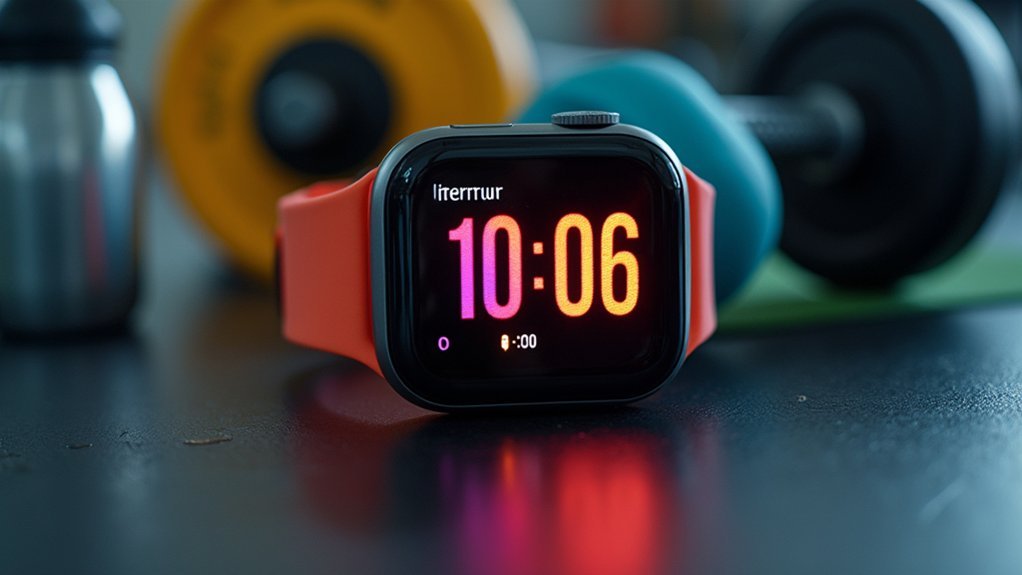
Selecting the right interval timer can dramatically enhance your fitness journey, as different training goals require specialized timing features and functionality.
For HIIT enthusiasts, Wear OS’s Exercise Timer and Apple’s Intervals Pro offer extensive options with wrist-based tracking and spoken prompts.
Runners should consider Samsung Health’s preset runs or Intervals Pro’s distance/time goals for pace-driven sessions.
If you’re strength training, look for apps with reps-based tracking like Exercise Timer, which allows self-paced sets with manual progression.
For yoga and flexibility work, prioritize timers with adjustable hold periods and meditation intervals. Intervals Pro excels here with Apple Health integration to log flexibility alongside other workouts. The app also provides standalone Apple Watch support allowing you to complete your yoga sessions without carrying your iPhone.
Fitness coaches will appreciate Exercise Timer’s client workout planning features, while Intervals Pro’s cross-platform sharing enables easy distribution of timer templates.
Using Voice Commands to Control Your Interval Workouts
Voice control technology has evolved considerably in smartwatches, though its application for interval workouts remains somewhat limited. Most current models require you to use buttons or touch interfaces to adjust interval settings during your workout, with voice commands primarily reserved for general navigation and basic functions. Some interval training apps like the custom interval training app mentioned support multiple languages and voices for spoken alerts during your workout sessions.
The future looks promising for hands-free interval workout control. Upcoming smartwatch generations may offer:
- Voice-activated interval adjustments that let you modify durations mid-workout
- Seamless switching between workout modes through simple voice prompts
- Integration with AI assistants for more natural voice interaction during exercise
Until then, you’ll need to rely on your watch’s physical controls for most interval workout adjustments, though you can often use voice commands for simpler tasks like starting or stopping your session.
Battery Optimization During High-Intensity Interval Training
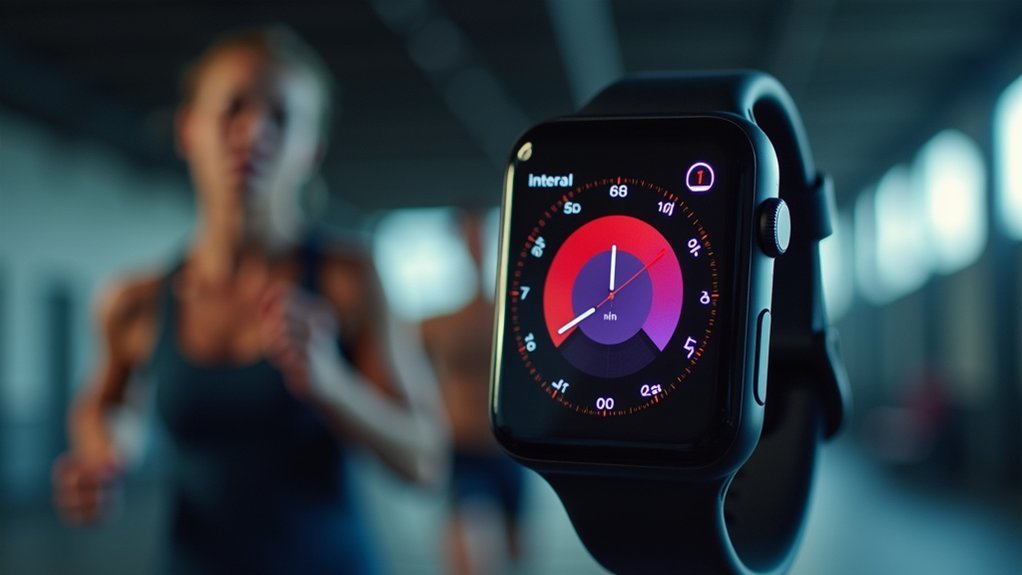
Maximizing your smartwatch’s battery life becomes essential when engaging in high-intensity interval training (HIIT), as these workouts can rapidly drain power through constant sensor activity and display interactions.
Enable power-saving or essential mode to limit background processes while retaining timer functionality.
For immediate battery savings, disable unnecessary sensors during indoor workouts—turn off GPS, SpO2 tracking, and extend heart rate monitoring intervals. Regularly check your watch’s battery usage to identify which specific fitness tracking features consume the most power during your HIIT sessions.
Simplify your display by choosing monochrome watch faces, disabling always-on display, and shortening screen timeout to 5-10 seconds.
Connectivity is another major battery drain. Activate airplane mode during workouts or at minimum disable voice assistants and limit notifications to essential apps only.
For longer sessions, consider manually starting activities rather than relying on auto-detection.
Smartwatch Interval Timers for Specific Sports and Activities
Smartwatch interval timers have evolved to meet the unique demands of various sports and activities, offering specialized features beyond basic countdown functionality.
Whether you’re running, cycling, or strength training, you’ll find tailored options to enhance your workout experience.
For specific sports, smartwatches provide:
- Running intervals with automatic phase detection between sprints and recovery, using Samsung Health’s customizable training settings that sync visual and auditory cues.
- Cycling workouts with GPS and speed sensor integration that automates intervals while keeping your hands free for safety.
- Strength training timers that display exercise names, repetition counts, and set tracking while accommodating complex workout schemes.
Many watches also integrate physiological data from heart rate monitoring to help you adjust intensity and optimize recovery between intervals. Apple Watch offers dedicated apps like Simple Stopwatch that provide HIIT interval training features while monitoring heart rate data that syncs with the Health app.
User Interface Design for Effective Interval Training
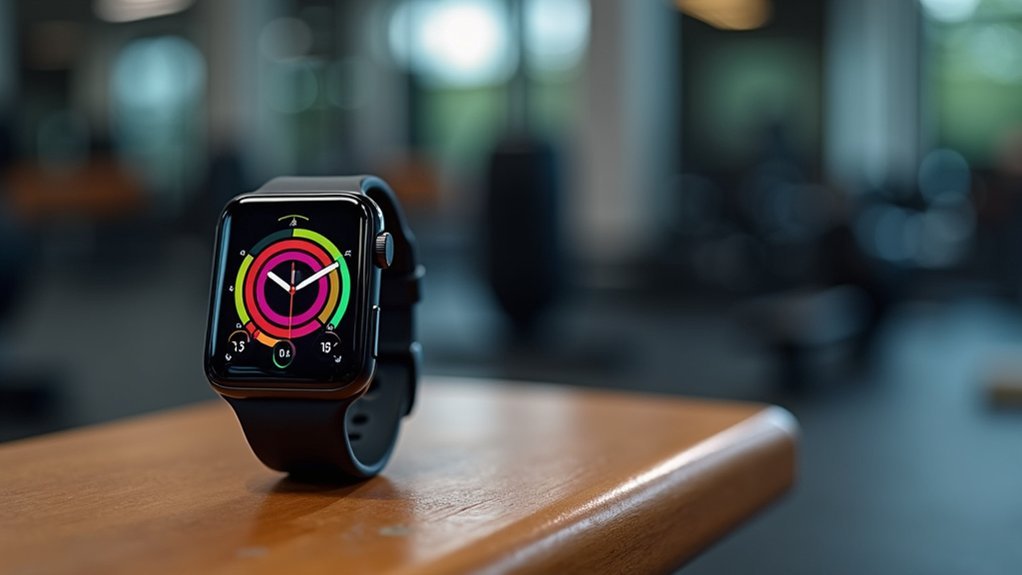
While the functionality of interval timers provides the foundation for effective training, the user interface design determines how efficiently you’ll interact with your smartwatch during workouts.
Modern smartwatches prioritize readability with large fonts and contrasting colors that remain visible even during intense movement or bright sunlight. Visual countdowns, progress bars, and clear interval labels (“WORK”, “REST”) let you monitor your status at a glance. Specialized models like the Fibex Sport Timer Watch offer 15 programmable vibrations for more customized interval training experiences.
Effective interval training interfaces combine bold visuals and intuitive cues that guide your workout without distracting from it.
You’ll appreciate the flexibility of physical buttons and touchscreen controls that allow you to start, pause, or skip intervals without breaking stride. Many watches combine auditory and haptic feedback, using customizable sounds and vibrations to signal changes without requiring you to check your screen.
Most interfaces also support saving multiple workout presets and screen locking to prevent accidental touches during your training session.
Syncing and Sharing Your Interval Workout Results
Once you’ve completed your interval training session, your smartwatch can transform that workout data into valuable insights through robust syncing and sharing capabilities.
Modern devices automatically sync with health platforms like Apple Health via Bluetooth, storing your performance metrics in the cloud for access across multiple devices. The Amazfit smartwatch specifically integrates with the Zepp App to analyze your health and training data comprehensively.
Your workout data becomes more valuable when shared effectively:
- Social connectivity – Share results directly to social media or via email to coaches for feedback
- Data exportability – Export to CSV files or third-party apps for deeper analysis
- Cross-platform functionality – Access your workout history across different devices and platforms
With regular firmware updates improving these features, you’ll benefit from increasingly sophisticated data analytics that help optimize your training regimen over time.
Frequently Asked Questions
Can Smartwatch Interval Timers Work Without Internet Connection?
Yes, your smartwatch’s interval timers work perfectly offline. They’re designed to function independently without internet, storing workout protocols locally on the watch. You’ll still get all alerts and tracking features during your exercises without connectivity.
Are Interval Timer Vibrations Strong Enough for Underwater Workouts?
Most smartwatch vibrations aren’t strong enough underwater as water density dampens the sensation. You’ll likely miss alerts during swimming workouts. Consider using sound alerts instead if your watch supports underwater audio features.
How Do Interval Timers Affect Watch Battery Life?
Interval timers consume moderate power but can drain your battery when used with other features. You’ll save energy by turning off the screen between intervals and disabling unnecessary background functions during workouts.
Can Smartwatch Interval Timers Be Used During Sleep Tracking?
No, smartwatch interval timers aren’t typically used during sleep tracking. Your watch’s sleep features are designed to monitor continuously rather than in intervals, focusing on cycles and patterns without interrupting your rest.
Do Interval Timers Work With Third-Party Fitness Apps?
Yes, most smartwatch interval timers work with third-party fitness apps through data sharing interfaces like HealthKit or Garmin Connect. You’ll find they complement your existing fitness ecosystem by sharing workout metrics and activity data.
In Summary
Smartwatch interval timers have evolved from simple counters to sophisticated training tools that adapt to your specific needs. You’ll find options ranging from basic work/rest timers to complex programmable intervals that integrate with your health metrics. Whether you’re a casual exerciser or competitive athlete, today’s smartwatches offer the interval functionality you need, with intuitive interfaces that make tracking and sharing your progress easier than ever.

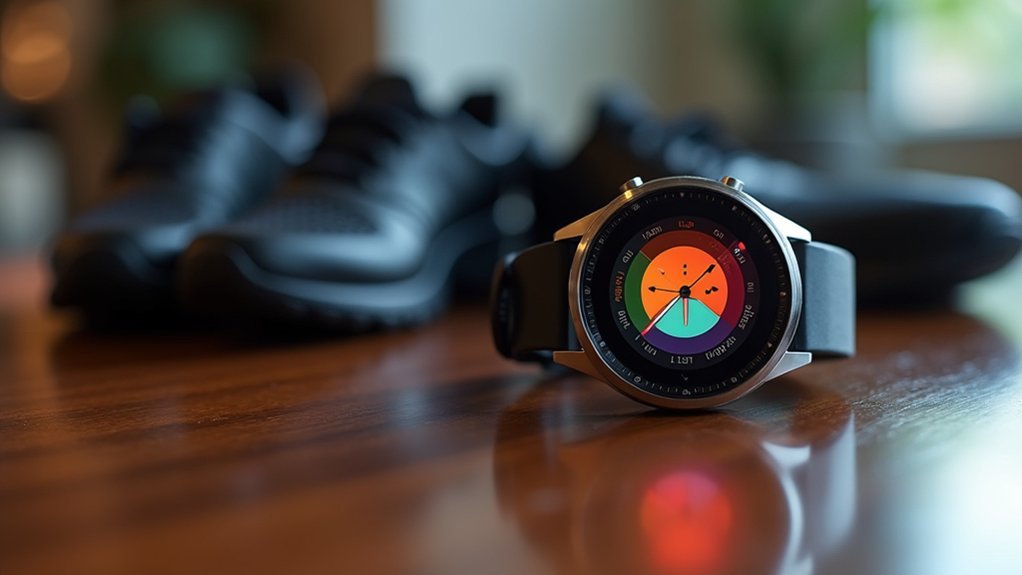



Leave a Reply